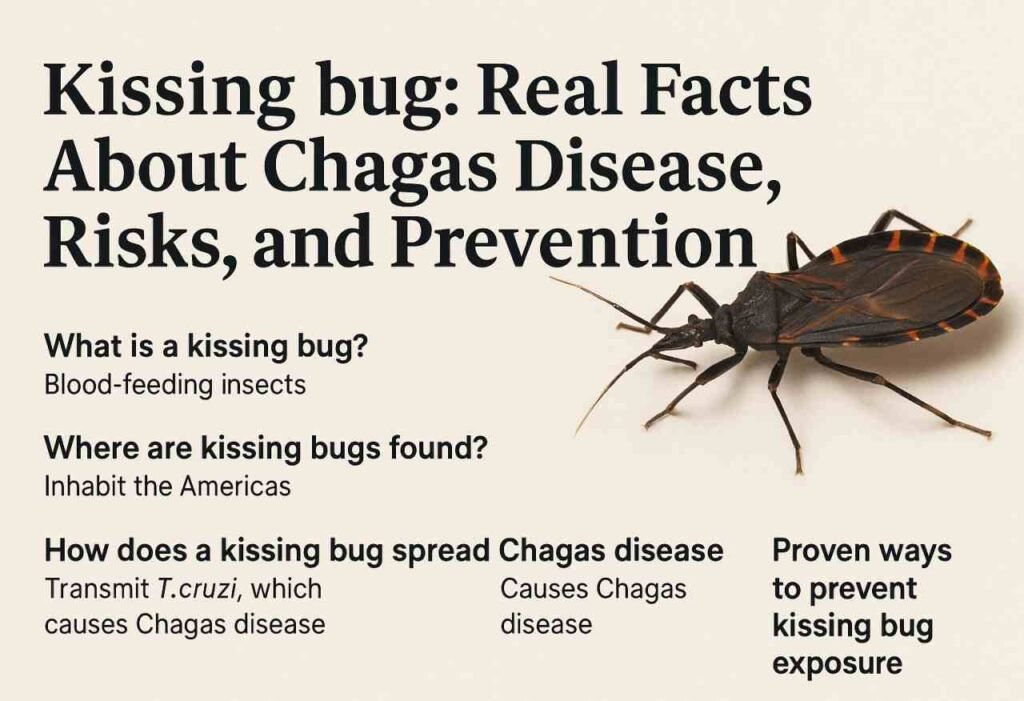Kissing Bug: Real Facts, Risks, and Prevention (2025 Guide)
Learn what the kissing bug is, where it lives, how it spreads Chagas disease, allergy risks, treatment options, and proven prevention steps; backed by CDC, WHO, and PAHO sources.
Kissing bugs (triatomine bugs) are blood-feeding insects that can transmit Trypanosoma cruzi, the parasite that causes Chagas disease. Transmission typically happens when the bug defecates near the bite and the parasite-containing feces enter through the skin or mucous membranes—not from the bite or saliva itself.
What is a kissing bug?
“Kissing bug” is a common name for several triatomine species (family Reduviidae) found mainly in the Americas. In the U.S., multiple species occur; they’re nocturnal, feed on blood, and sometimes enter houses or animal shelters.
Where are kissing bugs found?
Chagas disease is endemic across 21 countries of continental Latin America. In the U.S., triatomines occur naturally in the southern half of the country and have been identified in 32 states, according to a recent analysis in CDC’s Emerging Infectious Diseases.
How does a kissing bug spread Chagas disease?
- Primary route: After feeding, some triatomines defecate near the bite. Scratching can rub parasite-laden feces into the wound or eyes/mouth.
- Other routes: Congenital (mother-to-baby), blood transfusion, organ transplantation, laboratory accidents, and occasionally oral transmission via contaminated food/drink.
- Not saliva: The parasite is in the bug’s feces, not in its saliva or the bite itself.
Symptoms: what to watch for
- Acute phase (often mild or unnoticed): Fever, fatigue, body aches, headache, rash, diarrhea/vomiting, and sometimes Romaña’s sign (eyelid swelling).
- Chronic disease (years later in ~20–30%): Cardiac conduction abnormalities, cardiomyopathy; less often digestive “megasyndromes.” Early treatment is more effective; once organ damage is established, antiparasitic therapy won’t reverse it.
Are kissing bug bites dangerous beyond Chagas?
Yes! bites can provoke significant allergic reactions, including anaphylaxis in some people, particularly in parts of the U.S. Southwest. Seek urgent care for breathing trouble, throat/tongue swelling, fainting, or widespread hives.
Testing and treatment
Two antiparasitic medicines—benznidazole and nifurtimox (Lampit®)—kill T. cruzi. They’re most effective when given early (acute or recent infection); efficacy drops as infection becomes long-standing. In the U.S., both are FDA-approved for pediatric use; adults may be treated based on clinician judgment.
Proven ways to prevent kissing bug exposure
- Traveling in endemic areas: Stay in well-built, screened or air-conditioned rooms; use long-lasting insecticide-treated bed nets; wear long sleeves/pants and apply repellent to exposed skin; avoid unpeeled/raw produce and unpasteurized juices.
- Around homes/kennels (Americas): Seal wall/roof cracks; reduce clutter and woodpiles near buildings; bring pets indoors at night or house them in well-sealed kennels; consult professionals for residual insecticide spraying when appropriate.
Understanding THE Most Dangerous Pesticides and Protecting Your Health
If you find a kissing bug
Avoid bare-hand contact. Capture it in a container or bag using gloves, clean the contacted surfaces (e.g., 10% bleach solution), and check local/state guidance on submitting specimens (e.g., Texas A&M programs).
Fast facts (for context)
- Global burden: WHO estimates 6–7+ million people are infected worldwide.
- United States: CDC estimates about 280,000 people are living with Chagas disease, most undiagnosed.
FAQs about the kissing bug
Do all kissing bugs carry T. cruzi? No. Infection rates vary by region and species. Correct identification matters and many look-alike bugs don’t transmit Chagas.
Can I get Chagas from a single bite? Not from the bite itself. Risk comes from the bug’s feces entering a wound/eye/mouth after a feed.
Is Chagas “now endemic” in the U.S.? A CDC journal analysis argues it should be recognized as endemic (hypoendemic), with triatomines detected in 32 states; public health authorities emphasize screening and prevention.
“Kissing bug” and relies on primary guidance from the CDC, WHO, PAHO, and academic sources. If you need patient-specific advice, please consult a healthcare professional.
Sources: PinterPandai, WHO, CBS News, CDC, PAHO

